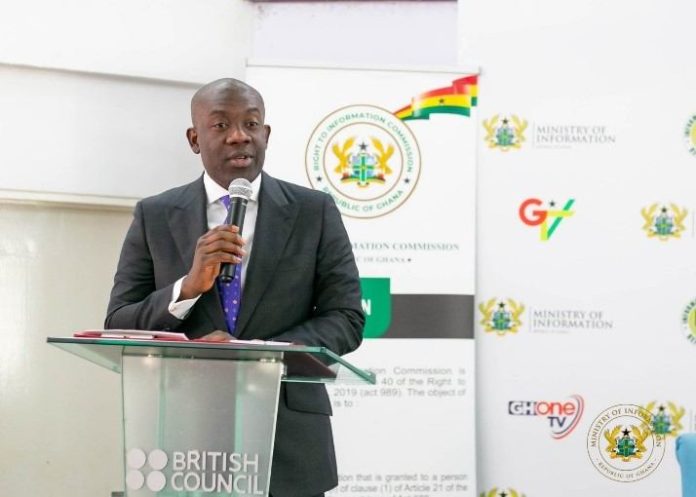Distinguished Guests, Ladies, and Gentlemen,
You may, by now, be aware of my passion for the Right to Information Act since I assumed office as the Minister responsible for Information. I stand before you today with great privilege and pride to address this distinguished gathering as we discuss the transformative journey of Ghana’s implementation of the Right to Information Act. Our collective pursuit of transparency and openness has again brought us together, around a piece of research that tries to trace the trajectory of this significant legislative milestone.
The journey to pass a right to information law in Ghana lasted two decades. The initial draft of the RTI law was introduced in 1999 in order to operationalise the fundamental right to information guaranteed under Article 21 (1)(f) of the 1992 Constitution. Ghana finally signed the bill into law in 2019 after five political administrations. The law came into full force in January 2020. The law was consistent with the international laws and treaties that Ghana is a signatory to, notable of which is the African Union Convention on Preventing and Combating Corruption. The law grants the public access to information generated and held by public institutions subject to exemptions that are necessary in a democratic society. The enactment of the Right to Information Act, 2019 (Act 989) in Ghana has been rightly considered as a watershed moment in the history of our democracy. The law has become one of Ghana’s most important laws, as it sets an unprecedented framework that gives all persons the potent weapon to seek and receive information held by public institutions which had hitherto remained suppressed in the dusty files of bureaucrats under the garb of official secrecy and confidentiality.
As we gather here, we are not just reflecting on a mere piece of legislation; we are examining a pivotal stride toward a more accountable and democratic Ghana. The Right to Information Act, born from the collaborative efforts of policymakers, civil society, and citizens, signifies our commitment to fostering a culture of transparency and access to information.
THE RESEARCH
In the last quarter of 2022, the Ministry of Information commissioned research to document the processes leading to the passage, implementation, and enforcement of the Right to Information (RTI) Act, 2019 (Act 989) in Ghana. The study examined the operational strategies adopted for the smooth implementation of the RTI Law, identified the major roles of civil society organisations and other stakeholders in the implementation process of the law, and finally we faced and continue to face in the implementation of the right to information law in Ghana.
The primary technique of inquiry was in-depth interviews. Using a purposive sampling technique, individuals from different stakeholder groups and public institutions who were involved in the implementation of the RTI Act, 2019 (ACT 989) were identified and interviewed. The institutions include the Parliament of Ghana, the Ministry of Information, the Right to Information Commission, Civil Society Organizations, Ministries, Departments and Agencies (MDAs) as well as Metropolitan, Municipal and District Assemblies (MMDAs). In all, 14 respondents were interviewed for the study.
The study also relied on secondary data available in the public institutions that led to the implementation of the Act in 2020. These include letters, roadmap reports, annual reports, training reports, and mystery shopping stress test results, among others. The data was analysed using qualitative content analysis and thematic analysis, where data collected was coded into thematic categories. Thick descriptions were given to the processes involved in the implementation of the Act and reported outcomes were themed for analysis.
Research Findings
Passage of RTI in Ghana
- Political Will
Several factors led to the passage of the RTI law in Ghana. It must be noted that these factors often overlap. For this reason, it remains extremely complex to assess the weight of one dimension compared to another. The first factor identified here was political will and commitment. The political administration in 2019 was determined to have the bill passed into law. The RTI bill, which had been in and out of parliament for two decades was reintroduced to parliament under a certificate of urgency. This action demonstrated the commitment of the Legislative arm of government to pass the Bill into law. Similarly, the President also “never hesitated, and then appended his signature” to the law the moment it was brought to his attention, demonstrating the commitment and the political will from the Executive arm of the government to implement the RTI law.
- Role of CSOs
The second factor refers to the increasing public protests and advocacy of a sophisticated network of Civil Society Organisations (CSOs) with a strong interest in transparency and accountability, like the CSO Coalition on RTI (known as RTI Coalition). For instance, the RTI Coalition embarked on public awareness campaigns, media engagements, lobbying, research and advocacy activities, persisting and modifying its strategies along the way to suit the conditions of each period during the struggle for an effective RTI law (CHRI, 2019). The Coalition also organized a series of news conferences, workshops and strategic meetings across the country, and leveraged the significance of 28th September each year (Right to Know Day). Civil Society, Media and other stakeholders have played significant roles in the passage and implementation of the RTI Act (ACT 989). Their role can be recounted to the twenty years leading to the passage of the Law. Indeed, “the bill itself was crafted by civil society organisations.”
The implementation phase of the RTI
- Deferment clause: Peculiar to the RTI Act, 2019 is a deferment clause which meant that though it was assented to by the President in 2019, its application began in the ensuing financial year, i.e. January 2020. This significant provision meant that the implementation of the law could not commence immediately after presidential assent in May 2019. The transition period allowed the implementing Ministry to put in place institutional arrangements for a smooth take-off.
- Framework for implementation
For RTI to be effective, three organs have to work together and work efficiently. The Supply Side (Information Officers / Units), Demand Side (General Public) and the Regulatory Side (RTIC). The interrelation between these organs is facilitated by the sector Ministry, the Ministry of Information. No single organ can on its own make RTI Work effectively.
Supply Side
Effective implementation of the RTI law in Ghana called for a specific set of activities to put the intent of the Right to Information law into practice. The Ministry of Information recognising this undertook specific activities aimed at ensuring smooth implementation of the law.
- Pre-implementation Engagements with Stakeholders
The Ministry of Information conducted a series of consultations with various stakeholders on the implementation of the Right to Information Act (RTI) law in Ghana. Representatives from various institutions, including Parliamentary News Africa, the Parliamentary Select Committee on Constitutional and Legal Affairs, the Right to Information Coalition Ghana, and the Embassy of the Federal Republic of Germany, were invited to draft a work plan and roadmap for implementation. Chief Directors of MDAs and Regional Coordinating Directors of MMDAs were also engaged to brainstorm and agree on compliance with the law while avoiding breaches of the Data Protection Act. The engagement of relevant stakeholders was emphasized as a primary activity for the smooth implementation of the law.
- Implementation Road-map
A roadmap was developed to ensure the smooth operationalization of the Right to Information Act (RTI Act) after extensive engagements with key stakeholders. The roadmap identified key activities and responsible agencies for the implementation, including setting up a committee at the Ministry with representatives from the RTI Coalition, PRAAD, OHCS, and other stakeholders. The roadmap also identified timelines for various activities and allowed for easy assessment of milestones. Key activities in the roadmap were the implementation budget for the 2019 and 2020 fiscal years, aligning PRAAD to service records departments, setting up an ATI Division under the Information Services Department, and appointing members of the Governing Board for the RTI Commission.
- Deployment of Information Officers
In showing fidelity to the implementation roadmap, the Ministry of Information through the ATI Division requested all Chief Directors and Heads of Local Government and Civil Services, respectively to nominate an officer as a Designated RTI officer and a records officer, both to assist in the processing of RTI requests. In all, Nine Hundred and fifty-six (956) officers were designated from 478 public institutions in 2020.
In addition, the Ministry of Information, with the assistance of the Head of Civil Service recruited one hundred (100) RTI Officers comprising five principal information officers and 94 assistant information officers who were deployed to various public institutions as RTI officers. By the close of the year 2022 three hundred and fifty (350) had been recruited and posted to various public institutions. One Hundred and Eighty-Seven (187) of them have been posted to MMDAs, Sixty-six (66) to SIGA institutions and Ninety-seven (97) to MDAs across all the sixteen regions.
- Capacity Building
The Ministry of Information aimed to build the capacity of frontline officers and other officers involved in the implementation of the RTI law. Training of designated information and records officers began in March 2020 but was disrupted by the COVID-19 outbreak and resumed in July 2020 via a virtual platform. The training process involved face-to-face engagement with various institutions from the MDAs to the MMDAs. The importance of training officers is a key component in the implementation of the law. There is a need to explain nuances in the Act, such as classes of information classified as exempt from disclosure. International organizations and Civil Society Organizations have also undertaken some form of training.
- Inclusion of RTI compliance as a KPI in the Chief Director’s performance agreement
The Ministry, through the ATI Division in collaboration with the Office of the Head of Civil Service (OHCS) successfully included RTI compliance in the performance agreement for Heads of institutions as a key performance indicator. Thus, today, compliance with the RTI Act is a must for Chief Directors of MDAs.
- Development of Online Records Management System (ORMS)
The Ministry, through the ATI Division, and in consultation with the RTI Commission, successfully developed an Online Records Management System (ORMS) to enable applicants to apply for information online, aid information officers in keeping accurate records, and improve application response times. This unique platform, which has been developed in accordance with Section 18 of the RTI Act, 2019, will not only digitise the application and processing of RTI requests but will also transform records management across public institutions in the country. The ORMS is expected to be in full operation in 2024.
Demand side
The successful implementation of the RTI law in Ghana partly depends on the demand for access to information by individuals, institutions, or groups. In accordance with Section 1 of Act 989, a person is the one who has the right to information and may apply for access to that information. It is important for citizens to understand that in some limited circumstances, as outlined in sections 5 to 16 of Act 989, public institutions have a right, to exempt some classes of information from access under this Act. The RTI Commission, however, as an independent and impartial body, has also been resourced to deal with any unwarranted denials by public institutions.
In the first year of implementation, eighty-five (85) requests for information were recorded and processed across all public institutions, but the number increased to one hundred and eighty-nine (189) requests in 2021. In 2022, public institutions received and processed Seven hundred and eighty-three (783) applications. Information officers interviewed attributed the low number of applications to a lack of information and understanding of the application processes by the public. They also noted that applicants often made improper requests, suggesting they do not understand and interpret certain provisions of the law well.
However, some CSOs and journalists who have been crucial in assessing the impact of the RTI Law on the Ghanaian democratic scene hold a different view. One of the respondents stated that they have made over 100 requests to over 70 institutions, but more than half of them had not received any response. They noted that the response rate, however, was getting better with time as more institutions became aware of their obligations, with MDAs having a slight advantage to RTI exposure compared to MMDAs. Respondents agreed that the issue of the low response rate can be attributed to low sensitization and awareness within public institutions.
Regulatory functions by the RTI Commission
The Right to Information Act 2019 (Act 989) mandates the establishment of an independent body to promote, monitor, protect, and enforce the right to information. In October 2020, the President inaugurated the Governing Board of the Right to Information Commission, which has since recruited 120 staff to perform various responsibilities.
Since its establishment, the RTI Commission executed the following major tasks:
- Securing the prosecutorial mandate from the Attorney-General of the Republic
The Commission successfully secured an Executive Instrument conferring on it, prosecutorial powers in accordance with section 56 of Act 30 and Article 88(4) of the 1992 Constitution. This serves as a measure to help strengthen enforcement undertaken by the Commission. In accordance with E.I 378, the RTI Commission has the power to and has commenced prosecution of offenses under the RTI Act.
- Conduct of compliance surveys
In 2022, compliance surveys were conducted by the Commission in One Hundred and Forty-Nine (149) public institutions. Fifty-one (51) of the One Hundred and Forty-Nine (149) institutions were found to be non-compliant, representing 34.23% of institutions monitored. The Commission recorded Ninety-Eight (98) out of the One Hundred and Forty-Nine (149) monitored institutions as compliant, which represents 65.77% of institutions monitored. For the institutions deemed non-compliant, limited knowledge of the Act, was identified as a contributing factor.
- Determination of review applications
Ninety-Five (95) applications for review were filed with the Commission during the period under review. Twenty-seven (27) of the total applications went through the full process and determinations were made by the Commission. Thirty-one (31) were settled through Alternative Dispute Resolution (ADR) means and Twenty-seven (27) of the applications are at different stages of review as at the time of putting this document together.
- Promotion of the right to information
One of the functions of the Commission is to participate in the promotion of RTI in accordance with Section 45 of Act 989. In accordance with this provision, the Commission undertook a series of activities aimed at sensitising persons and institutions on the RTI Act. Some of these activities included the provision of training to management and staff of some public institutions and collaborating with some public institutions, civil society organisations, and media houses to educate the public on the right to information and Act 989.
The Commission’s independence is guaranteed by Section 42 (1)(2) of the RTI Act, which states that it is not subject to the direction or control of any person or authority. The Executive Secretary and Commissioners have worked to assert the Commission’s independence, and the Commission operates in accordance with the law, ensuring that decisions are backed by the law.
ENFORCEMENT OF THE RTI LAW
The research identified three different models for the institutional framework and enforcement of the RTI legislation. These are enforcement through judicial proceedings, the information commission or tribunal, and the informational commissioner or ombudsman. Their frameworks are based on context and content.
- Enforcement through Judicial Proceedings
This model directs all appeals to the judiciary when a request for information is refused based on the condition that the public organization deems the circumstances unsatisfactory to the request. This model is used in countries such as Nigeria, South Africa, Bulgaria, Israel, and the United States of America which are countries known to practice the federal system of government. When an individual is denied access to the information upon request, they can appeal to the courts directly. One advantage that this model of implementation holds is the certainty that the request for information has a high initial plausibility of being granted if the requester was denied inappropriately based on the powers given to these courts to investigate and their ability to pursue the appropriate punitive measures to the organization or public official for non-compliance. However, this model is also fraught with some disadvantages that weigh more than the perceived advantages. The principal disadvantage is how costly these appeals to the courts are as well as the delay in trials and the depreciating faith that has been reposed in the judicial system by the citizens.
- Information Commission or Tribunal (Order Making Agencies)
With this model, the information commissions or tribunals are institutions or organizations that have been established to help with the resolution of cases in relation to denied access to information, thus reducing the workload of the courts. In this model, there are appeals that are made to various special appeal tribunals known as the information commission or tribunals that have been mandated with the power to make rulings and orders that are binding before the court comes in (if there is still that need). This has been estimated to be the best of the three models and is practised in countries like India, Scotland, Mexico, and Ireland. The popularity and efficiency of this model are based on its adherence to international standards on access to information and increasing awareness for countries to adopt the model. This is because this model presupposes that the Information Commissioner has the power to make decisions that are binding and will enhance more effective implementation. In terms of advantages, this model has been touted to be autonomous, less costly, accessible to all, timely, and often spearheaded by someone who specialises in access to information. But this model is also fraught with some challenges. The organizational structure and nature of proceedings in these information tribunals make them similar to the courts in function and process, making them too formally and legally daunting.
- Information Commissioner or Ombudsman (Recommendation-making agencies).
This model entails the use of an information commissioner or an ombudsman for the enforcement of the access to information law. But unlike the other models discussed above, the information commissioners in this model have limited capacities for the enforcement of the law because they have weaker investigative power, and their power exclusively is to make recommendations to the public organization. Unlike the Information tribunal with the power to make binding decisions and orders, in this model, the information commissioner lacks the power to make orders and is quick to suggest and facilitate negotiations and mediation between the requestor and the public organization. Countries that are known to adopt this type of model include federal systems like Canada, Hungary, Sweden, Australia, Spain, and New Zealand
This model is characterized by a distinctiveness that is seen in how reasonable and just their recommendations are, although not binding considered to be very potent. This is because, the ombudsman is granted the power to investigate and as such, has access to the domains of the public organizations. The investigative power is also augmented with order-making power often within the confines of compelling organizations to declassify documents, often resorted to when judicial appeals are to be filed. Additionally, the ombudsman has supervisory power over legislation that has the propensity to affect the right to information, hence helping consolidate the rights. what makes this model unique is the degree of legitimacy enjoyed by the ombudsman and its impact on his or her duties since they are approved by two-thirds of the parliament. The independence of the ombudsman office is assured since it is not part of the parliamentary bureaucracy.
Its advantages include a high degree of accessibility to applicants due to reduced formalities. There is also a speed associated with their duties. One potent disadvantage of this model is the possibility that there is a lack of adherence to the recommendations of the ombudsman because its decisions are not binding.
Model adopted by Ghana
In terms of the institutional framework and enforcement of the legislation, Ghana is practicing a hybrid of the three models espoused above. The Right to Information Commission is the body mandated to enforce the legislation. In line with the first model of enforcement through judicial proceedings, Act 989 clearly outlines the processes for appeal by dissatisfied applicants and therefore the judiciary is not the body that handles all appeals. In addition, the Commission has been granted prosecutorial FIAT to prosecute offences under Act 989. Additionally, the Commission is finalizing the setting up of a tribunal to adjudicate some of the matters before it. These arrangements satisfy the second model espoused, which is the Information Commission or Tribunal system. Finally, the third model entails the use of an information commissioner or an ombudsman for the enforcement of the access to information law. In having a hybrid structure, the best of the three models has been adopted in other to minimize any disadvantages that go with each model.
Challenges confronted in the Implementation of the RTI
Robust implementation of any public policy is difficult to achieve and may face a plethora of challenges. The study identified the following challenges:
- Resource Constraints
Respondents acknowledged resource constraints as the biggest challenge in implementing the Law, with limited funds and other resources for the operations of both the Access to Information Division and the RTI Commission and the training personnel.
- The institutional culture of silence and secrecy
The behavioural change challenge affects public institutions’ full embrace of the law, as they are used to working within a culture of secrecy. The RTI law is vital in providing legal background for individuals and journalists to exercise their right to access information. However, challenges include ignorance of the law, and deliberate refusal by public agencies to provide information they feel might incriminate them or expose a rotten system.
- Delay in the passage of a Legislative Instrument (L.I)
The Legislative Instrument (L.I) is a crucial accompaniment to an Act, providing details about the nuances of the Act and facilitating its implementation. Without the L.I., certain aspects of the law can be difficult to implement. The absence of the L.I. can lead to challenges, such as the ambiguity in the law regarding the number of days for processing an initial information request. There is a statute requiring the accompanying legislative instruments to be presented to Parliament within twelve months after an Act has been passed into law.
- Public Records Keeping and Digitization
Public Records management across State institutions has become a challenge in the implementation of the RTI law. That is why the Ministry of Information put in place measures to address the issue using technology with the development of an Online Records Management Systems.
PROSPECTS FOR THE RTI LAW
Collaboration
Collaborative policy-making is crucial for establishing new networks among stakeholders and increasing knowledge distribution. Respondents advocated for a coordinated workforce from ATID, NCCE, ISD, and RTIC to create public awareness about the right to information. Through continuous public sensitization and education, the law will protect and empower the people, while building strong, transparent and accountable public institutions.
Ingrained Structures
The importance of proper structures in maintaining focus and preserving the essence of the Right to Access Information (RTI) Law in Ghana cannot be emphasised. Respondents noted that one of the best things to happen to journalism since the 1992 constitution is the RTI Law. However, without improvement and ingrained structures, the RTI law in Ghana may suffer the same fate as other West African countries.
Leadership
Respondents emphasized the importance of committed leadership for the effective implementation of the RTI Law. They believe that building the capacity of officers and institutions and having committed leadership is crucial for the law’s success.
RECOMMENDATIONS
Immediate passage of the Legislative Instrument for RTI Act (Act 989)
The research recommends the immediate passage of the Legislative Instrument (L.I) to regulate the implementation of the RTI law in Ghana. The L.I. should detail the specifics of the Act, making it easier to implement. It should clarify areas like whether weekends are counted in the 14-day period and clarify the calculation of weekdays. The operationalisation of the RTI law commenced over three years ago.
Political Will and Commitment
The passage of the Right to Information law is commendable but insufficient if not effectively implemented. It requires commitment from politicians, and government officials, support from political administrations, timely budget allocations, and serious treatment of decisions by public institutions. It is strongly recommended that budgetary allocations be made available on time to the RTI Commission so that it can carry out its duties without financial constraints. Finally, public institutions to which the RTI Commission decisions are directed should treat such decisions seriously and comply fully; otherwise, they should be found in contempt and individuals in those institutions held liable for disregard of the Commission’s authority.
Civil Society Organizations
Civil society has the potential to play a significant part in maintaining the law’s consistent and effective application. It was obvious that the CSOs in Ghana played a substantial role leading up to the adoption of the law. It is important to involve CSOs in the process of operationalising the law since omitting them could have negative effects on how well the law is put into effect. To ensure the effective implementation of the RTI Act, the RTI Commission and the Ministry of Information should continue to involve key stakeholders, particularly CSOs as they may play important roles in influencing people to use the law.
Continuous Capacity building for information officers
The government should take the necessary steps to ensure that every public institution has an information officer or a person designated to whom requests for information may be made, as required by the law. These information officers need continuous training on the duties required of them by law. This will equip them with the requisite knowledge and skills to handle RTI requests and ultimately excel at their positions.
Public education and Sensitization
The RTI Commission and the Ministry of Information, through the Access to Information Division of the Information Services Department, should be adequately resourced to enable them to educate and raise awareness about the RTI law nationwide. This will help citizens and the general public understand how to file an RTI request in a way that is simple and easy. RTI should be promoted in all educational institutions. This will be an effective and long-term way to make people aware of this important law and also encourage people to use their right to know.
The media also has a big part to play in making sure people know about the RTI Act. Journalists, in particular, can do a lot to get the word out about the RTI law by publishing reports and success stories about the RTI Law.
There should be sensitisation and awareness of the right to information law at the institutional levels. This needs concerted efforts from the both RTI Commission and the ATI Division of the Ministry of Information. This will ensure that there is a fundamental shift in the mindsets of political heads, bureaucrats and public servants who are the custodians of information at the various public institutions. Proactive disclosure should be promoted as this will not only facilitate full disclosure but also reduce the cost of information requests. Information can be proactively disclosed by public institutions on their official websites, manuals, reports, magazines, and other media channels. This will facilitate the timely response of the relevant institution to requests for information.
CONCLUSION
As we stand on the precipice of a more transparent future, let us consider the insights gleaned from this research as guiding stars. Our commitment to the Right to Information must be unwavering, and our resolve to address challenges resolute. The data and narratives presented today are not just reflections of the past; they are blueprints for a future where transparency is not a goal but a way of life.
In conclusion, let this discussion be a platform for shared wisdom, collaborative strategies, and renewed commitment. The Right to Information Act is not merely a legal text; it is a promise to the people, a covenant that binds the government and its citizens in the pursuit of a more accountable and transparent society.
Thank you for your attention, and I wish you all fruitful deliberations.

























